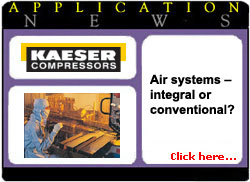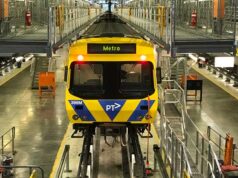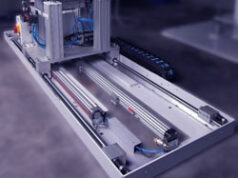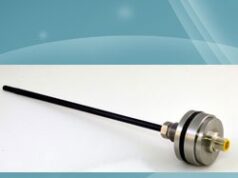Air systems – integral or conventional?
For many years now, compressor manufacturers and distributors have been fabricating packages to combine compressors with accessories such as tanks, dryers and filters. This popular concept allowed customers to customize their compressed air system while reducing installation costs. These package units were very popular with small shop and facilities in the under 25 HP market.
Recently, larger compressors have undergone similar developments with the inclusion of variable speed drive technology and the addition of integral refrigerated dryers. In addition to optimizing design time, installation costs are becoming increasingly affordable with excellent return on investment.
Clearly, these integrated systems offer advantages in many applications. However, there are other considerations. Many factors should be evaluated and considered when choosing between integrated package systems and conventional systems with separate components.
Generally speaking, industrial compressed air installations include one or more compressors, receivers, dryers compressed air systems are more complex than they seem. Compressors should include internal controls, and multiple unit systems may use a master system controller for optimum performance. Centrifugal separators or “wet tanks” should be installed down-stream of the compressors’ after-coolers to ensure effective water separation. Dry tanks to provide buffer capacity and compensate for fluctuating compressed air demand are also recommended in most systems. Refrigerated or desiccant dryers must be selected and sized according to the application and specific environmental conditions.
The facility where the system is housed has to meet technical ventilation requirements plus ambient air quality plays a role in determining components. While integral systems might meet some of these needs, conventional systems have their benefits as well. The best system for the application results from a clear understanding of the specific process air quality requirements, air demand profile and facility limitations or potential.
A refrigerator in an oven – a paradox?
Designing compressors with integral dryers can present a real challenge to manufacturers. The reason? Compressors and refrigerated dryers have completely opposing characteristics. A compressor converts almost all of its input energy into heat, which is discharged into the ambient surroundings. A refrigerated dryer requires cool ambient surroundings in order to use as little energy as possible to cool and dry the compressed air. Air systems manufacturers must address: How do I integrate a refrigerator (refrigerated dryer), and other heat-sensitive components, into an oven (compressor) so that both units still provide outstanding performance? While this may seem like a paradox at first, it is technically possible.
Cheap comes at a cost.
Sadly, some “budget” solutions offer a good deal on the initial purchase price by downgrading the refrigerated dryer to nothing more than a “better” after-cooler and using proportional control to regulate the compressor. These quickly prove to be ineffective at best and wasted capital at worst. The real solution is to accept the opposing characteristics of the compressor and the dryer, and design the system to prevent the compressor from thermally affecting the refrigerated dryer.
Space is a premium.
Space limitations and other physical design factors add to the challenge of component selection. Compressors are often tucked away In a dark corner with little space and poor ventilation. Components are placed “where they fit” without proper regard to intake or discharge. These mistakes can drastically reduce efficiency and compressed air availability. Combine these factors with harsh environments and contaminated ambient air, and the cost of maintaining compressed air reliability sky rockets.
With these considerations, end users are increasingly eager for solutions that reduce planning and installation work while also providing considerable space-savings. Integral compressed air systems are an excellent choice in these situations, and are even better when manufacturers have piped and wired them for quick and easy installation.
Essential: Condensate separation, efficient control and storage
Condensate separation is another important aspect. A pre-separation system must be installed between the after-cooler and the refrigerated dryer to eliminate the 70 to 80 percent of condensate that accumulates there. This type of Integral system eliminates the need to pipe and install individual components, plus it requires far less floor space than a conventional installation.
It is a mistake to assume that only large conventional systems require a “buffer” or “dry” tank. Alt systems can benefit. An appropriately sized storage receiver helps maintain a stable system pressure and provides buffer capacity for short periods of high demand.
Integral units should also include an efficient internal control system for both the compressor and the dryer. In addition, if the system and cabinets is designed to allow easy access to all service-relevant components, reduced maintenance costs can be added to the list of benefits.
Location is critical.
It is equally important to consider the system’s location in relation to where the compressed air is actually used. For example, assume a situation where the ambient temperature is over 100 ° F, but the compressed air is used in an air-conditioned environment at only 68 °F. In an integral system with a refrigerated dryer, the pressure dew point is very near or only fractionally above, the condensate precipitation limit. With the air humidity above 50%, there is the significant risk of corrosion. However, with a conventional air system installation air treatment equipment can be specifically tailored and the compressed air can be delivered with a pressure due point of 3a°F even under such difficult operating conditions. As a result, there is no risk of damage from condensate accumulation or corrosion.
With the many advantages of integral systems, users may assume that there is no longer a need for a separate compressor room. Plus, today’s fully enclosed rotary screw compressors are exceptionally quiet. Once again, the complete picture should be examined. Is the heat generated by compression ducted away for more efficient use? Or is it allowed to dissipate in the surrounding environment? In dirty or contaminated environments, the compressor will suck in the various contaminates through the intake like a giant vacuum cleaner. This can lead to increased maintenance costs and the risk of breakdown. To ensure maximum air availability and optimum efficiency, carefully select the system’s location to account for ventilation and worker comfort.
The compressor and refrigerated dryer will always discharge a volume of heat that corresponds to the unit’s power, and this heat has to be managed by the installation facility’s ventilation system. In many cases, end-users choose to duct both conventional and integrals systems to recover the heat generated by compressed.
When integral units make sense.
Systems with integral air treatment are ideally suited to applications were floor space is limited, and the required compressed air volumes are relatively low. Facilities such as machine shops, automotive service outlets, and small-to-medium industrial manufacturers are perfect examples of applications where clean dry air is essential, but large, cumbersome systems are prohibitive.
By the nature of their design, the dryer in an integral system is presized and it is not possible to control an additional dryer or use a larger one. Integral systems produce pressure dew points as lowas38°F. Higher ambient temperatures will increase the pressure dew point. However, applications that require condensate-free compressed air can add specific filtration downstream.
When conventional units provide better performance.









